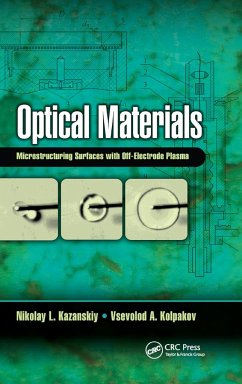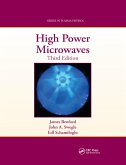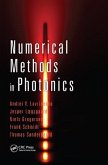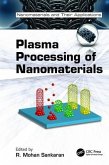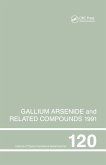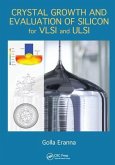Nikolay L Kazanskiy, Vsevolod A Kolpakov
Optical Materials
Microstructuring Surfaces with Off-Electrode Plasma
Nikolay L Kazanskiy, Vsevolod A Kolpakov
Optical Materials
Microstructuring Surfaces with Off-Electrode Plasma
- Broschiertes Buch
- Merkliste
- Auf die Merkliste
- Bewerten Bewerten
- Teilen
- Produkt teilen
- Produkterinnerung
- Produkterinnerung
This reference book concentrates on microstructuring surfaces of optical materials with directed fluxes of off-electrode plasma generated by high-voltage gas discharge and developing methods and equipment related to this technique.
Andere Kunden interessierten sich auch für
![High Power Microwaves High Power Microwaves]() James BenfordHigh Power Microwaves72,99 €
James BenfordHigh Power Microwaves72,99 €![Numerical Methods in Photonics Numerical Methods in Photonics]() Andrei V LavrinenkoNumerical Methods in Photonics82,99 €
Andrei V LavrinenkoNumerical Methods in Photonics82,99 €![Plasma Processing of Nanomaterials Plasma Processing of Nanomaterials]() Plasma Processing of Nanomaterials113,99 €
Plasma Processing of Nanomaterials113,99 €![Gallium Arsenide and Related Compounds 1991, Proceedings of the Eighteenth INT Symposium, 9-12 September 1991, Seattle, USA Gallium Arsenide and Related Compounds 1991, Proceedings of the Eighteenth INT Symposium, 9-12 September 1991, Seattle, USA]() Gerald B StringfellowGallium Arsenide and Related Compounds 1991, Proceedings of the Eighteenth INT Symposium, 9-12 September 1991, Seattle, USA68,99 €
Gerald B StringfellowGallium Arsenide and Related Compounds 1991, Proceedings of the Eighteenth INT Symposium, 9-12 September 1991, Seattle, USA68,99 €![Optics Essentials Optics Essentials]() Araz YacoubianOptics Essentials92,99 €
Araz YacoubianOptics Essentials92,99 €![Crystal Growth and Evaluation of Silicon for VLSI and ULSI Crystal Growth and Evaluation of Silicon for VLSI and ULSI]() Golla ErannaCrystal Growth and Evaluation of Silicon for VLSI and ULSI90,99 €
Golla ErannaCrystal Growth and Evaluation of Silicon for VLSI and ULSI90,99 €![Echoes of War Echoes of War]() Bernard LovellEchoes of War96,99 €
Bernard LovellEchoes of War96,99 €-
-
-
This reference book concentrates on microstructuring surfaces of optical materials with directed fluxes of off-electrode plasma generated by high-voltage gas discharge and developing methods and equipment related to this technique.
Hinweis: Dieser Artikel kann nur an eine deutsche Lieferadresse ausgeliefert werden.
Hinweis: Dieser Artikel kann nur an eine deutsche Lieferadresse ausgeliefert werden.
Produktdetails
- Produktdetails
- Verlag: Taylor & Francis Ltd (Sales)
- Seitenzahl: 211
- Erscheinungstermin: 10. Dezember 2019
- Englisch
- Abmessung: 234mm x 156mm x 12mm
- Gewicht: 331g
- ISBN-13: 9780367886264
- ISBN-10: 036788626X
- Artikelnr.: 58482601
- Herstellerkennzeichnung
- Libri GmbH
- Europaallee 1
- 36244 Bad Hersfeld
- gpsr@libri.de
- Verlag: Taylor & Francis Ltd (Sales)
- Seitenzahl: 211
- Erscheinungstermin: 10. Dezember 2019
- Englisch
- Abmessung: 234mm x 156mm x 12mm
- Gewicht: 331g
- ISBN-13: 9780367886264
- ISBN-10: 036788626X
- Artikelnr.: 58482601
- Herstellerkennzeichnung
- Libri GmbH
- Europaallee 1
- 36244 Bad Hersfeld
- gpsr@libri.de
VSEVOLOD KOLPAKOV is a doctor of physics and mathematics and a professor in the Department of Electronic Engineering and Technology at the Samara National Research University (Samara State Aerospace University), Samara, Russia. He is an expert in ionplasma technology and quality management, the author and co-author of 120 scientific publications, including 3 monographs, 2 textbooks, and 40 articles, and a co-inventor of 9 patents. NIKOLAY KAZANSKIY is head and acting director of the Diffractive Optics Laboratory at the Image Processing Systems Institute and a professor in the Technical Cybernetics Department at the Samara National Research University (Samara State Aerospace University), Samara, Russia. He is a member of SPIE and IAPR, the author and co-author of 240 articles and 10 monographs, and a co-inventor of 46 patents in diffractive optics, mathematical modelling, and nanophotonics.
Forming Directed Fluxes of Low Temperature Plasma with High Voltage Gas
Discharge Outside the Electrode Gap. Overview of Devices Used for
Generating Low-Temperature High Voltage Gas-Discharge Plasma. Features of
Low-Temperature Off-Electrode Plasma Generated by High Voltage Gas
Discharge. Design Changes to the High-Voltage Gas-Discharge Device. New
Devices for Generating Directed Fluxes of Low-Temperature Off Electrode
Plasma. Multibeam Gas-Discharge Plasma Generator. Chapter Summay. Methods
for Quickly Measuring Surface Cleanliness. Overview of Methods for Quickly
Measuring Surface Cleanliness. The Method of Frustrated Multiple Internal
Reflection Spectroscopy. The Method of Measuring the Volta Potential.
Methods for Evaluating Cleaning Efficiency Based. On Wettability of the
Substrate Surface. The Tribometric Method. Design Changes to the
Tribometer. Operating Regimes and Parameters of the Tribometer. Determining
the Evaluation Criterion of a Technologically Clean Surface. Tribometric
Effect of the Substrate-Probe on the Structure of the Test Surface.
Measuring Surface Cleanliness with the Tribometric Method . A Cleanliness
Analyser Based on Analysis Of Drop Behavior. Evaluating the Cleanliness of
a Substrate from the Dynamic State Of a Liquid Drop Deposited on Its
Surface. Specifications of the Micro- and Nanoroughness Analyser. Design
Changes to the Micro- and Nanoroughness Analysis. Chapter Summary.
Increasing the Degree of Surface Cleanliness with Low-Temperature off
Electrode Plasma. Overview of Methods for Surface Cleaning. Chemical
Cleaning. Laser Cleaning. Low-Temperature Plasma Cleaning. Formation
Mechanisms of Surface Properties. Molecular Structure Analysis of the
Organic Contaminant. Preparing Initial Samples with a Given Degree of
Contamination. Analysis of Plasma Particles Impinging on the Surface Being
Treated. Mechanism of Surface Cleaning with Directed Fluxes of
Low-Temperature Off-Electrode Plasma. Cleaning Mechanisms. Cleaning
Model-Primary E
Discharge Outside the Electrode Gap. Overview of Devices Used for
Generating Low-Temperature High Voltage Gas-Discharge Plasma. Features of
Low-Temperature Off-Electrode Plasma Generated by High Voltage Gas
Discharge. Design Changes to the High-Voltage Gas-Discharge Device. New
Devices for Generating Directed Fluxes of Low-Temperature Off Electrode
Plasma. Multibeam Gas-Discharge Plasma Generator. Chapter Summay. Methods
for Quickly Measuring Surface Cleanliness. Overview of Methods for Quickly
Measuring Surface Cleanliness. The Method of Frustrated Multiple Internal
Reflection Spectroscopy. The Method of Measuring the Volta Potential.
Methods for Evaluating Cleaning Efficiency Based. On Wettability of the
Substrate Surface. The Tribometric Method. Design Changes to the
Tribometer. Operating Regimes and Parameters of the Tribometer. Determining
the Evaluation Criterion of a Technologically Clean Surface. Tribometric
Effect of the Substrate-Probe on the Structure of the Test Surface.
Measuring Surface Cleanliness with the Tribometric Method . A Cleanliness
Analyser Based on Analysis Of Drop Behavior. Evaluating the Cleanliness of
a Substrate from the Dynamic State Of a Liquid Drop Deposited on Its
Surface. Specifications of the Micro- and Nanoroughness Analyser. Design
Changes to the Micro- and Nanoroughness Analysis. Chapter Summary.
Increasing the Degree of Surface Cleanliness with Low-Temperature off
Electrode Plasma. Overview of Methods for Surface Cleaning. Chemical
Cleaning. Laser Cleaning. Low-Temperature Plasma Cleaning. Formation
Mechanisms of Surface Properties. Molecular Structure Analysis of the
Organic Contaminant. Preparing Initial Samples with a Given Degree of
Contamination. Analysis of Plasma Particles Impinging on the Surface Being
Treated. Mechanism of Surface Cleaning with Directed Fluxes of
Low-Temperature Off-Electrode Plasma. Cleaning Mechanisms. Cleaning
Model-Primary E
Forming Directed Fluxes of Low Temperature Plasma with High Voltage Gas
Discharge Outside the Electrode Gap. Overview of Devices Used for
Generating Low-Temperature High Voltage Gas-Discharge Plasma. Features of
Low-Temperature Off-Electrode Plasma Generated by High Voltage Gas
Discharge. Design Changes to the High-Voltage Gas-Discharge Device. New
Devices for Generating Directed Fluxes of Low-Temperature Off Electrode
Plasma. Multibeam Gas-Discharge Plasma Generator. Chapter Summay. Methods
for Quickly Measuring Surface Cleanliness. Overview of Methods for Quickly
Measuring Surface Cleanliness. The Method of Frustrated Multiple Internal
Reflection Spectroscopy. The Method of Measuring the Volta Potential.
Methods for Evaluating Cleaning Efficiency Based. On Wettability of the
Substrate Surface. The Tribometric Method. Design Changes to the
Tribometer. Operating Regimes and Parameters of the Tribometer. Determining
the Evaluation Criterion of a Technologically Clean Surface. Tribometric
Effect of the Substrate-Probe on the Structure of the Test Surface.
Measuring Surface Cleanliness with the Tribometric Method . A Cleanliness
Analyser Based on Analysis Of Drop Behavior. Evaluating the Cleanliness of
a Substrate from the Dynamic State Of a Liquid Drop Deposited on Its
Surface. Specifications of the Micro- and Nanoroughness Analyser. Design
Changes to the Micro- and Nanoroughness Analysis. Chapter Summary.
Increasing the Degree of Surface Cleanliness with Low-Temperature off
Electrode Plasma. Overview of Methods for Surface Cleaning. Chemical
Cleaning. Laser Cleaning. Low-Temperature Plasma Cleaning. Formation
Mechanisms of Surface Properties. Molecular Structure Analysis of the
Organic Contaminant. Preparing Initial Samples with a Given Degree of
Contamination. Analysis of Plasma Particles Impinging on the Surface Being
Treated. Mechanism of Surface Cleaning with Directed Fluxes of
Low-Temperature Off-Electrode Plasma. Cleaning Mechanisms. Cleaning
Model-Primary E
Discharge Outside the Electrode Gap. Overview of Devices Used for
Generating Low-Temperature High Voltage Gas-Discharge Plasma. Features of
Low-Temperature Off-Electrode Plasma Generated by High Voltage Gas
Discharge. Design Changes to the High-Voltage Gas-Discharge Device. New
Devices for Generating Directed Fluxes of Low-Temperature Off Electrode
Plasma. Multibeam Gas-Discharge Plasma Generator. Chapter Summay. Methods
for Quickly Measuring Surface Cleanliness. Overview of Methods for Quickly
Measuring Surface Cleanliness. The Method of Frustrated Multiple Internal
Reflection Spectroscopy. The Method of Measuring the Volta Potential.
Methods for Evaluating Cleaning Efficiency Based. On Wettability of the
Substrate Surface. The Tribometric Method. Design Changes to the
Tribometer. Operating Regimes and Parameters of the Tribometer. Determining
the Evaluation Criterion of a Technologically Clean Surface. Tribometric
Effect of the Substrate-Probe on the Structure of the Test Surface.
Measuring Surface Cleanliness with the Tribometric Method . A Cleanliness
Analyser Based on Analysis Of Drop Behavior. Evaluating the Cleanliness of
a Substrate from the Dynamic State Of a Liquid Drop Deposited on Its
Surface. Specifications of the Micro- and Nanoroughness Analyser. Design
Changes to the Micro- and Nanoroughness Analysis. Chapter Summary.
Increasing the Degree of Surface Cleanliness with Low-Temperature off
Electrode Plasma. Overview of Methods for Surface Cleaning. Chemical
Cleaning. Laser Cleaning. Low-Temperature Plasma Cleaning. Formation
Mechanisms of Surface Properties. Molecular Structure Analysis of the
Organic Contaminant. Preparing Initial Samples with a Given Degree of
Contamination. Analysis of Plasma Particles Impinging on the Surface Being
Treated. Mechanism of Surface Cleaning with Directed Fluxes of
Low-Temperature Off-Electrode Plasma. Cleaning Mechanisms. Cleaning
Model-Primary E

